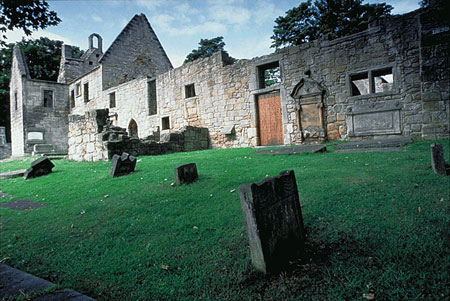
St Bridget's Kirk sits alongside the
shore of Dalgety Bay, Fife. The kirk was granted to the
Abbey of Inchcolm by William the Lion, and was in existence some
time before 11 March 1178, as it is mentioned in a Papal Bull
written by Pope Alexander III declaring that "The Church at
Dalgety with its appurtenances" be founded. Appropriated at that
time by Inchcolme Abbey, it was consecrated in 1244 by David de
Bernham, Bishop of St. Andrews. The nearby
abbey of Inchcolm provided a canon to act as its priest.
After the Reformation of 1560, three aisles
were added on north and south, for the use of the local lairds. At
the west end a more elaborate, two-storeyed addition was erected,
in the early 17th-century, as an aisle and vault for Alexander
Seton, 1st Earl of Dunfermline (d. 1622) and his family. The Earl
served both as Lord President of the Court of Session and as
Chancellor of Scotland, and was much respected for his great
learning and judicial ability. Here lie buried the 1st, 2nd and
3rd Earls of Dunfermline.
After the reformation, local lords
built "Laird's Lofts" (private side wings). The most comfortable
of these was the Seton loft, to the west, and this can still be
reached by a winding stair. There are many interesting grave
stones in the kirk and kirkyard including some from the 17th
century with skull and crossbones or craft symbols like tailor's
scissors. The eastern end of the kirkyard has a Mort house where
mourners used to keep watch on their deceased relatives to prevent
grave robbers taking the bodies. Presently, each year, a service
is still held here even though the church is in ruins with the
roof collapsed. Of Seton's favourite nearby residence, Dalgety
House which overlooked the church, not so much as a stone remains.